The King's Highway: The road that reveals Jordan's history
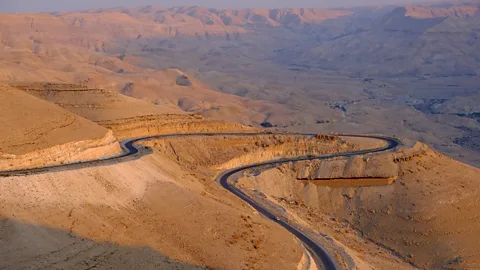 Marta Vidal
Marta VidalIt's mentioned in the Bible, it been used by a succession of empires and it links some of Jordan's most important historical sites.
"Welcome to Jordan!" a group of kids shouted excitedly, as I stepped out of the car to admire the sun setting over the vast sandstone canyon of Wadi Mujib.
While I stood on the cliff's edge, awestruck by the mountain ranges stretching to the Dead Sea, a black-and-white hooded wheatear swooped down near me. I wondered how something so delicate could survive in such desolate ravines, fluttering across the arid mountains and building nests in rock crevices.
From my perch, I could see a narrow, serpentine road winding down the ridges and gorges. This route, known as the King's Highway, or Darb ar-Raseef ("paved road", in Arabic), is believed to be one of the world's oldest continuously used roads. For millennia, merchants, pilgrims, warriors and kings travelled north to south through Jordan's central highlands, and this thoroughfare served as a vital artery connecting ancient kingdoms and empires.
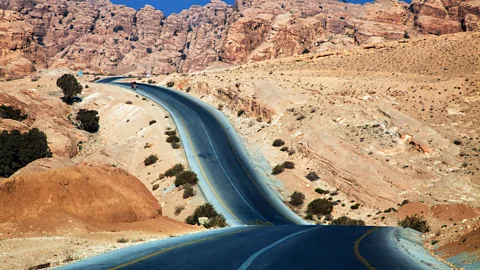 Anna Stowe Travel/Alamy
Anna Stowe Travel/AlamyToday, a modern, tarmacked road (officially called Highway 35) sits atop its ancient ancestor. It runs south from Syria along the Jordan River, passing through Roman ruins, Byzantine mosaics, Crusader castles and the ancient city of Petra – effectively revealing the history of Jordan and linking some of its most important historical sites.
"This route was used in the Nabataean period [4th Century BCE to roughly 106 CE], and probably even before that, in the Iron Age," said Fawzi Abudanah, an archaeologist who has studied the region's ancient road system.
The Best of 2025
Jordan was named one of BBC Travel's 25 best places to visit in 2025, a list highlighting destinations that are not only welcoming visitors, but using tourism as a force for good. See the full list here.
A road traversing Jordan known as the "King's Highway" is mentioned in the Bible's Old Testament as the route that Moses asked permission to cross after leading the Israelites out of Egypt. As Abudanah explained, since there is archaeological evidence showing Edomite, Nabataean, Roman, Byzantine and Islamic presence along much of the current highway, it suggests that this road has been in continuous use since at least the 8th Century BCE. "We keep following the footsteps of our ancestors," he said.
According to Abudanah, in ancient times, the King's Highway was an important trade route connecting Arabia, the Fertile Crescent, the Red Sea and Egypt. Caravans transporting incense and spices from Arabia took this road on their way to the thriving Nabataean capital of Petra. In the Roman period, emperor Trajan (who reigned between 98-117 CE) renamed the route Via Nova Traiana and paved it to accommodate wheeled carts. "We can still find Roman milestones on the side of the modern road," Abudanah said.
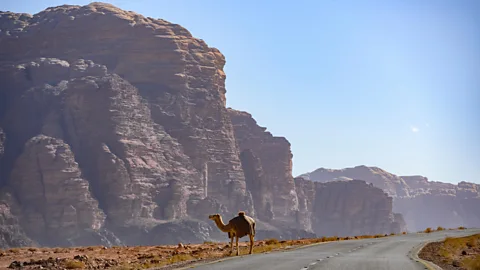 Travel Wild/Alamy
Travel Wild/AlamyFor centuries, the road was also an important pilgrimage route. In the Byzantine period, Christians used it on their way to visit biblical sites in the Holy Land, such as Golgotha, the site of Jesus crucifixion. In the early Islamic period, many Muslims travelled along it on their way to Mecca.
I lived in Amman, Jordan's capital on and off for several years, but always took the faster, easier roads heading south. When my cousin came to visit me, we decided the best way to explore the country's long and tangled history was to take the King's Highway and travel slowly along the path that the many civilisations who have shaped this ancient land once used.
The ancient road once passed by Amman's highest hill, occupied since the Bronze Age. So before leaving the capital, we wandered among the ruins of a Roman temple, a Byzantine church and an Umayyad palace, which reflect the history of Jordan's layered heritage.
We then travelled 30km south – past olive orchards, ripening pomegranates and rows of prickly pears – to the ancient town of Madaba. "The road crosses the most fertile part of the country, the area where you have springs and water sources, but also agricultural land. It's the backbone of Jordan," Abudanah told me.
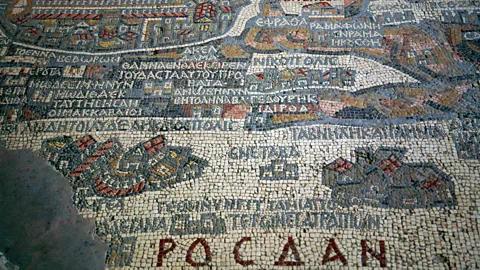 Yadid Levy/Alamy
Yadid Levy/AlamyMadaba is best known for its collection of Byzantine-era mosaics. The most famous of them, the remains of a 6th-Century floor mosaic housed in the modest St George Orthodox church, is considered the oldest surviving map of the Holy Land, and depicts various sites linked by the King's Highway. Near the church's altar, I tried to decipher the Greek captions indicating Jerusalem in the centre of the map, and marvelled at the details of fish swimming in the River Jordan and boats on the Dead Sea.
Nine kilometres west of Madaba, a short detour from the King's Highway led us to Mount Nebo, where Moses purportedly first saw the Promised Land, and where he's believed to have died and been buried.
In the Old Testament, Moses asks the King of Edom to pass through his land in what is now south-western Jordan. "We will stay on the main road until we leave your territory," he promised. But his request to travel along the King's Highway was denied. The modern road is far more welcoming – I was told "Welcome to Jordan" dozens of times, and was offered tea and invited for lunch and dinner by many locals I met along the road.
"People here are so kind and generous," said Sabine Hendriks, a Dutch tourist cycling along the King's Highway with her partner, heading south to the Red Sea port of Aqaba. "When we couldn't cycle up a very steep hill, a truck stopped to help us. It was already full, but somehow they managed to find space for us."
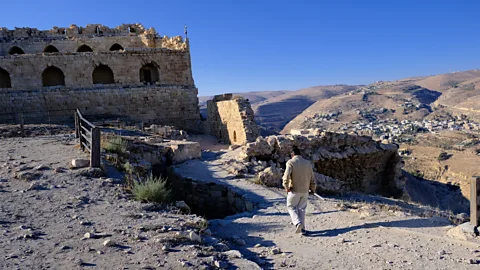 Marta Vidal
Marta VidalOn a quick stop to stretch our legs, a young man working in a bakery by the side of the road told us we were his guests and brought us a tray of sweets and warm date bread. Satiated, we continued south across the gently undulating plateau towards the Unesco World Heritage site of Umm ar-Rasas. When we reached the archaeological site it was already closing time, but a friendly guard named Alaa let us in anyway and offered to show us around.
Once a Roman garrison town, the site houses ruins from the Roman, Byzantine and Early Islamic periods. While we walked to the remains of an 8th-Century church (monastic Christianity was tolerated during Islamic rule), Alaa asked us to close our eyes, and we were only allowed to open them when we were in front of the site's renowned mosaics. I stood there consumed by the ancient towns and pomegranate trees depicted on the church's floor, wondering how the mosaics remained so vivid after more than 1,200 years.
We travelled along the valleys and rolling hills dotted with oak, cypress and juniper trees, the landscape becoming increasingly arid, and watched the sunset at Wadi Mujib. The next morning, we explored the medieval castle in the city of Kerak. Built in 1142 and retaken by Muslims in 1188, it is one the biggest and best-preserved Crusader fortresses in the Middle East. Fuad, a local guide, led us through the castle's many floors, some buried so deep we needed a torch to see the vaulted halls and underground chambers. He asked us to imagine Saladin, the legendary sultan who defeated the Crusaders, sitting there on a throne, their battles playing out against the backdrop of the ancient highway.
Continuing south along the meandering road, we passed by the Dana Biosphere Reserve, Jordan's largest and most diverse protected region. Spread over 292 sq km, this mountainous swath of the Great Rift Valley shifts from towering sandstone cliffs to desert plains. The plan was to visit the town of Shobak's imposing medieval castle. But instead, we stopped on a curvy by-road in the arid hills to drink coffee with Mohammad "Abu Ali" Al-Malaheem. When the former tour guide retired, he decided to build what he calls "the world's smallest hotel" – a battered Volkswagen Beetle lovingly decorated with his daughter's embroidery – that's become so popular, it has been visited by Jordan's King Abdullah II.
 Marta Vidal
Marta VidalAbu Ali gifted me a colourful beaded necklace made by local women. His generosity and endearing roadside hotel reminded me that while the King's Highway might have lost its importance as a major trade route, it's the people who you meet and experiences you have along the way that bring it to life.
After a purposefully slow, two-day, 250km road trip, we reached our final destination: Petra, which was declared one of the New Seven Wonders of the World. Few places can rival the splendour of the ancient Nabataean city carved out of red sandstone in the arid desert. Petra was once a great mercantile city at the crossroads of empires and ancient trade routes, and the road used by Nabataean caravans that made the region prosperous is now trodden by tourists who come from all over the world to visit the site's more-than-2,000-year-old temples, tombs and altars intricately carved into the narrow canyons.
Later that day, we stopped on a road outside of Petra to give a ride to a woman walking home after a long day selling souvenirs at the site's archaeological park. She introduced herself as Umm Khaled and, despite being exhausted from work, she invited us to her home in a nearby village.
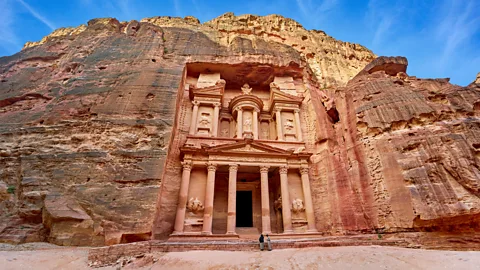 Jan Wlodarczyk/Alamy
Jan Wlodarczyk/AlamyMost of the Bedouin tribes in the area still depend on the Nabataean paths. Umm Khaled, who belongs to the Ammarin tribe, told me how difficult it was to make ends meet when the roads were emptied of visitors during the pandemic, and how her family is still struggling. Insisting I come back for tea, Umm Khaled showed me how, even through hardship, she and many others are able to make the desert a hospitable place.
Heading back to Amman with the promise to visit her again, I thought about the black-and-white bird I saw in the ravine of Wadi Mujib and how throughout history, people here have managed to carve extraordinary monuments from these rocks and breathe life into this arid landscape. The King's Highway not only showcases the most important phases of Jordan's history, but also reveals what makes the country so special: the surprising possibility of finding beauty, kindness and generosity even in the most difficult of places.
The Open Road is a celebration of the world's most remarkable highways and byways, and a reminder that some of the greatest travel adventures happen via wheels.
---
Join more than three million BBC Travel fans by liking us on Facebook, or follow us on Twitter and Instagram.
If you liked this story, sign up for the weekly bbc.com features newsletter called "The Essential List". A handpicked selection of stories from BBC Future, Culture, Worklife and Travel, delivered to your inbox every Friday.
